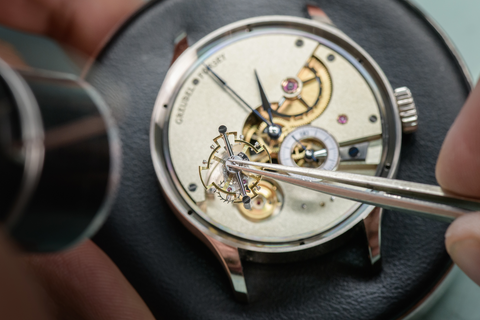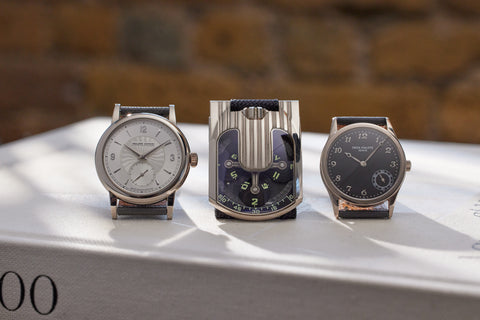While David Candaux established his eponymous independent in 2017, his watchmaking is inspired in part by born into a family who for generations had been steeped in the tradition as well as the 17 years he spent working at Jaeger-LeCoultre. A student of the École Technique de la Vallée de Joux, he credits Gabriel Locatelli and Philippe Dufour’s mentorship for the nature of his craft.
Candaux announced his brand with the distinctive DC-1, featuring the manually wound calibre 1740 and an inclined tourbillon. The first series featured only eight watches, of which this is one. Candaux’s small manufacture, where he works closely with his father Daniel Candaux, produces much of what goes into the watches, while sourcing cases, dials and components such as screws, axles and jewels from external suppliers.
The bassinet-shape stainless-steel case is 43mm across, extending at 6 o’clock to house the crown. The concave bezel is minimal at 12 o’clock, progressively increasing in scale and widest at the crown. It features a facet where it meets the complex shape of the midcase. This part features a polished facet followed by a inclined form that reduces the footprint of the case. The lugs, gently stepped, are screwed on to this part of the case. In the space between the lugs are two screwed on inserts that give the flanks a smooth, continuous form. The lugs are brushed on top and polished in profile. Their distance is furnished with a woven nylon strap, bolstered with soft leather and secured by Velcro. The buckle features an insert of the brand’s mark – a bear that references the watchmaker’s nickname.
The ‘Couronne Magique’, or magic crown as the brand refers to it, is a multi-patent set up. It is sheathed within a cylinder with brushed sides and a polished concave bezel, mirroring the overall shape and finish of the case. Pressing down on the crown – embossed with the brand’s logo – releases it. Pulling it out to the first position helps set the time, while by extending it one click further helps wind the manually wound calibre 1740. The architecture, composed of 31 parts, is designed to be water resistance up to 94m. Such weather sealing represents a rarity in the world of haute horlogerie.
The dial, crafted from gold and completed with a frosted finish, is inclined at a 3º angle so the parts that express information are raised to meet the wearer’s eye. The inclined dial means the muted black rehaut is minimal in the northern half, and progressively more pronounced coming to the 6 o’clock position. Contained within a high polished stainless-steel rim, graduated at five-minute intervals, is the frosted gold dial. It plays with light, shimmering brilliantly one second and vanishing into the background the next. In this first series, the brand name and place of origin is printed in the northern half, while the brand credo of “Le coeur & l’esprit” – heart and mind – are laser engraved at 6 o’clock.
The stainless-steel rim framing the dial continues, contiguous with the aperture that contains the tourbillon as well as the time display. The tourbillon and time displays both occupy the same visual footprint. The one-minute tourbillon, inclined at a 30º degree angle means that the oscillator will almost never find itself vertically aligned – the position least suited to the concentric breathing of the hairspring – for any length of time, even when the watch is laid down in between wear. Crafted from titanium, like much of the calibre 1740, the heat blued carriage is finely detailed and finished. It’s angle further accentuates the depth of the aperture that holds it.
The blue of the tourbillon carriage is repeated again on both the large central seconds indicator as well as the syringe-style hours and minutes hands on the white opal time display. This subsidiary register features a quarter chapter of faceted hour markers completed with printed Arabic numerals. A chapter of printed minutes lies outside it. The central portion features a stainless-steel rim. The dial also features an arced stainless-steel window with a blue power reserve indicator counting down the 55 hours of autonomy that the twin barrels afford the movement.
The calibre 1740, conceptualised in-house by Candaux and crafted entirely from titanium, has a terraced architecture, cascading gradually from the top bridge to the bottom-most one. The form of the bridges, rising and falling to meet the curvature of the wheels of the going train, feature edges precisely finished with mirror-polished anglage. On top, these bridges are finished with diagonal striping that the brand refers to as ‘Côtes du Solliat’. They appear as even waves, rising and falling to lend dramatic texture to the movement side appearance.
The bridges anchoring the going wheels are black polished while the jewels on which the gears pivot feature gold chatons. Other visible jewels feature mirror polished countersinks. Details such as the calibre designation, jewel count (47 rubis) as well as the brand mark and place of origin are laser engraved on the bridges. Golden plaques featuring the serial number out of eight as well as the brand mark and logo are affixed to the bridges. The minimal bezel that frames the view of the calibre protrudes in, with the space featuring engraved details such as the brand, “1740 Les 8 Premiéres”, as well as the serial number out of eight.
This watch comes with its full set of inner and outer boxes as well as warranty paperwork and instructions. The new owner will have the option to have the watch serviced by the brand within the first six months of ownership.
This example of the DC-1 First of Eight is remarkable for a number of reasons. It represents a truly original take on fine watchmaking powered by the watchmaker’s grasp of micromechanics and his desire to create something special yet equal to the rigours of regular wear.
If sold within the United Kingdom, this David Candaux DC1 1740 First 8 will be subject to 20% VAT













































































































































































































